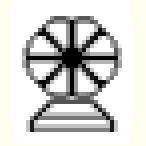 | ||
A mann (also known as a guard, sage, commoner, or prince) is a chess piece that can move like a king, but is not otherwise treated as one (i.e., it is not royal). It is not used in modern (FIDE) chess, but is often used as a fairy chess piece in variant chess games.
Contents
Movement
The mann moves as a king (one square in any direction) but is not royal.
History
The mann is one of the most simply described chess pieces and as such has a long history and has gone by many names. It has been used since at least the 12th century where it was played in Courier Chess, and continued to be played in this game for at least six hundred years. Many chess variants have used the mann, and today is used in games such as the following:
Value
A mann is approximately equal in strength and value to a knight, generally. Often it takes a few moves to get the mann properly developed in the opening. It is effective at close proximity, where its striking power is considerable. Although it is rather slow, the mann is excellent at both attacking and defending nearby pieces and pawns, similar to the king (Ward 1996:13). The mann reaches its peak strength during the endgame, in which its value is slightly more than a knight, despite being slightly less than a knight in the opening.
Examples
The non-royal kings, archers, or manns are represented by inverted kings in the following examples.
